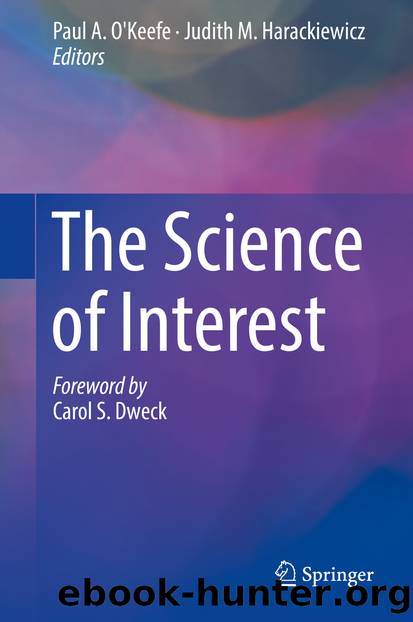The Science of Interest by Paul A. O'Keefe & Judith M. Harackiewicz

Author:Paul A. O'Keefe & Judith M. Harackiewicz
Language: eng
Format: epub
Publisher: Springer International Publishing, Cham
In an effort to summarize and integrate research findings on differences and changes related to interest development as a four-phase process , Renninger and colleagues have recently created a schematic overview (see, e.g., Renninger & Hidi, 2016; Renninger & Riley, 2013; Renninger & Su, 2012). This schematic specifies learner characteristics and beneficial contextual affordances for each of the four phases. Most of these characteristics are based on longer-term studies (e.g., Hidi & Renninger, 2002; Lipstein & Renninger, 2007) and include qualitative and mixed-method data, which is necessary to capture change on different levels as well as change that individuals might not be aware of themselves (Renninger & Bachrach, 2015). Learner characteristics at each phase highlight different experiential or behavioral aspects and knowledge requirements that are common to individuals in a certain phase. Such a schematic also helps to identify developmental thresholds between phases. For example, learners who display a strong focus on their curiosity questions by definition have reached a more developed phase of interest development than learners who do not (see, e.g., Renninger & Su, 2012). Such a schematic is both the result and the facilitator of research on interest development. For example, it may help establish clear guidelines for multidimensional measures that are able to distinguish between individuals with less-developed and well-developed interest .
Considered together, the main purpose of research on interest development is to better describe the continuum and the complex processes that move individuals from the less-developed end to the well-developed end. To this end, it seems most productive to define and empirically validate person characteristics and critical leverages for support as a function of different phases. At all phases, the role (and the match) of both person characteristics and environmental affordances is critical for development. Thus, it is not clear why two phases should be highlighted as “situational” and two phases should be highlighted as “individual.” “Less-developed” and “well-developed” seem to be more appropriate and less ambiguous labels.
Download
This site does not store any files on its server. We only index and link to content provided by other sites. Please contact the content providers to delete copyright contents if any and email us, we'll remove relevant links or contents immediately.
Invention by James Dyson(723)
Thinking Better by Marcus du Sautoy(680)
The Ten Equations That Rule the World by David Sumpter(668)
Concepts of Space by Jammer Max;(654)
God and the Multiverse by Victor J. Stenger(630)
Wanting by Luke Burgis(626)
Merchants of Doubt by Erik M. Conway(623)
How We Got to Now by Steven Johnson(597)
Factfulness by unknow(558)
The Surrender Experiment by Michael A. Singer(537)
The Smallest Lights in the Universe by Sara Seager(513)
On Creativity by Bohm David(488)
Floods, Famines, and Emperors: El Nino and the Fate of Civilizations by Brian Fagan(480)
Ancient Knowledge Networks by Eleanor Robson;(479)
Why Birds Matter by University of Chicago Press(470)
The Science of Being Lucky: How to Engineer Good Fortune, Consistently Catch Lucky Breaks, and Live a Charmed Life by Peter Hollins(462)
The Scientist and the Psychic by Christian Smith(461)
The Oxford Handbook of Philosophy of Mathematics and Logic by Stewart Shapiro(450)
Flood by Design (Design Series) by Mike Oard(427)
